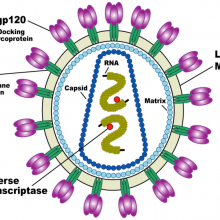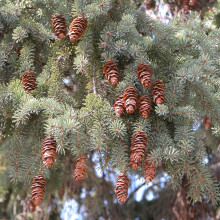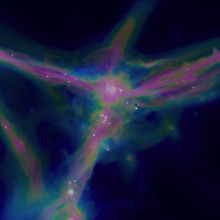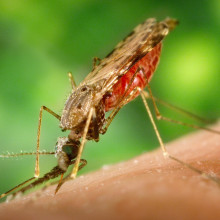Chemical Liposuction and Tracking the Flu
In this Naked Scientists NewsFlash, a new fat-busting injectible that selectively destroys adipose, evidence that only single strains of HIV are transmitted between partners and the discovery of two pristine primordial gas clouds produced by the Big Bang. Plus, the Flu Survey: a new citizen science initiative to gather data on the incidence of influenza like illnesses in the European population...
In this episode

00:24 - The HIV transmission bottleneck
The HIV transmission bottleneck
Researchers have found that the strain of Human Immunodeficiency Virus most abundantly present in the genital tract is not necessarily the strain that infects a sexual partner.
Unprotected heterosexual sex is the most common way that the HIV is transmitted, particularly in developed countries and Debra Boeras from Emory University in Atlanta and her colleagues studied heterosexual couples in Rwanda and Zambia who were 'sero-discordant' - i.e. one was HIV positive, and the other was only just diagnosed as HIV positive.
An HIV positive person can carry many strains of the virus present in their genital tract, as it mutates so rapidly (which is one of the reasons we're having a hard time trying to figure out a vaccine). But previous studies have shown that a single strain of HIV establishes infection in the new host, known as the 'transmission bottleneck', and through studying vaginal swabs, and semen and blood samples from 8 heterosexual couples the team confirmed that this was the case. If the infection was random, you'd expect that the strain of the virus that was most common in the genital tract would be more likely to cause infection in the sexual partner.
But when the researchers compared the gene sequences for proteins on the outside of the virus that vary between strains, they found that the strain in the blood of the newly infected partner was not the same as the most common strain in the genital tract of the chronically infected partner.

The team suggest that this is due to selection of the viral strain best suited for successful transmission rather than just the most abundant strain. So, many virus particles may be transmitted to the uninfected sexual partner, but most of them will not be able to infect the person. It is only the strain with the right attributes, such as more efficient binding to receptor proteins on host cells, that are able to infect a new host.
This finding is important, because we know that transmission of the virus is via the genital tract, but if the strain that actually manages to infect the other partner is not the commonest one in the genital tract, then there must be a mechanism at work that could affect our strategies to treat the virus and reduce onward infection rate.

03:17 - Chemical liposuction: fat-reducing injection success in primates
Chemical liposuction: fat-reducing injection success in primates
A fat-reducing drug, Adipotide, that can reverse obesity in monkeys has been successfully tested by US scientists.
The agent, which was injected daily over a four week study period into a group of naturally obese baboons, macaques and rhesus primates, contains of a short string of amino acids that cause the drug to lock selectively onto the walls of blood vessels that supply adipose tissue. Linked to this short, blood vessel-targeting protein sequence is a further chemical signal that causes cells that are exposed to it to commit suicide. This it achieves by triggering structures called mitochondria, which are essential energy-generating components inside cells, to break down. In this way the agent causes the chemical equivalent of liposuction, culling fat cells and causing weight loss.
Compared control animals, the treated monkeys showed weight reductions of  up to 14% and an average fat mass reduction of almost 40%. This translated into a body mass index (BMI) reduction of up to 20% and, just as overweight humans develop an insulin-resistant state that often leads to diabetes, the treated animals showed significantly lower insulin levels afterwards.
up to 14% and an average fat mass reduction of almost 40%. This translated into a body mass index (BMI) reduction of up to 20% and, just as overweight humans develop an insulin-resistant state that often leads to diabetes, the treated animals showed significantly lower insulin levels afterwards.
Surprisingly, the treated animals showed no signs of altered blood cholesterol or fatty acid levels while receiving the new agent, and there were no obvious behavioural side effects or evidence of altered eating behaviours during the study. The only thing that was picked up during the trial was a trend towards increased urine output and dehydration in animals receiving higher doses of the drug, although the relevance of this finding remains to be shown. The results offer a promising lead in the development of treatments to combat global obesity, which now affects up to one in five adults in many developed countries and carries a cancer risk elevation equivalent to being a regular smoker.
According to co-author Renata Pasqualini, "Development of this compound for human use would provide a non-surgical way to actually reduce accumulated white fat, in contrast to current weight-loss drugs that attempt to control appetite or prevent absorption of dietary fat." The team are now about to commence a human clinical trial involving a 28-day administration of the agent to patients with prostate cancer to determine whether their disease improves alongside the ensuing weight loss.

07:42 - Warming Earth not so good for Arctic tree growth
Warming Earth not so good for Arctic tree growth
A group of researchers from Columbia University publishing in the journal Environmental Research Letters have found that the growth of white spruce trees on the northern treeline in the far north of Alaska has shot up over the past 50 years. They've also managed to put forward an answer to the so-called 'divergence problem', where tree ring widths stop correlating with increasing thermometer-measured temperatures from the mid 20th century, and a possible alternative measurement as a solution to the problem.
Most people will be familiar with the use of tree rings in measuring time passing - with one ring for each year. But the width of the rings can also be used to estimate climate at the time when those layers of cells were laid down, known as a 'proxy' for when temperature measurements aren't available. The area where the researchers carried out their research is in very far North of Alaska, where tree growth is limited by temperature - so an increased average annual temperature would allow for a longer growing season and therefore wider tree rings, and also an increase in the maximum latewood density of each ring. 
Well, the team, led by Laia Andreu-Hayles and Rosanne D'Arrigo from the Tree Ring Laboratory at Columbia University's Lamont-Doherty Earth Observatory, have shown that in white spruce, while the tree ring width does indeed stop tracking the instrumental temperature increases seen after 1950, the maximum latewood density measurements do continue to follow the increased temperature. They suggest that this is because we have now reached a stage where temperature is no longer having a positive effect on growth. If you imagine a curve with temperature along the bottom and growth up the side - at first as the temperature increases, so does the growth, but after a certain point, although the temperature is still increasing, the graph levels off because growth is no longer responding. This could be down to the increased temperature actually stressing the trees, if there isn't also an increase in water availability. This is the situation the team found - the ring widths are larger post-1950, but their growth no longer correlates with temperature.
They suggest that using measurements of maximum latewood density might be a more accurate proxy for temperature measurements where temperature is 'no longer the primary factor controlling tree growth'. This would be a useful tool, especially in the face of criticism of the lack of correlation of ring width and temperature.

10:09 - Pristine primordial Big Bang gas discovered
Pristine primordial Big Bang gas discovered
Two gas clouds containing pristine samples of the gas spawned  by the Big Bang has been spotted by astronomers.
by the Big Bang has been spotted by astronomers.
Using the powerful, Hawaii-based Keck I telescope, University of California Santa Cruz graduate student Michele Fumagalli and his colleagues focused on two distant quasars, called J1134+5742 and Q0956+122. Quasars are intense light sources produced by superheated matter falling into massive black holes at the centres of galaxies. To reach Earth, the light from them has to pass through any clouds of gas that are in their paths.
By looking at the light that arrives, researchers can work out what is in the gas because different chemical elements absorb discrete wavelengths of light, producing a unique chemical fingerprint. But prior to now all of the gas clouds that have ever been reported have always shown signs of significant contamination with metals. These can only have come from early stars, which produce heavier elements by fusing lighter substances, like hydrogen, together.
This means that the compositions of these contaminated gas clouds cannot be relied upon to test theories about the Big Bang, and the sorts of elements and in what ratios, it produced. Current models of the Big Bang suggest that, after about 8 minutes, the newborn Universe cooled from a sizzling one billion Kelvin to about 500 million Kelvin, which is hot enough for new elements to be born and yet cool enough for them to be stable.
The result, theoreticians think, was a mixture comprising mainly hydrogen and its isotope deuterium, together with a bit of helium and a trace of lithium. Yet without some of the resulting gas to study, the model remained unsupported by experimental evidence.
But the new findings, which are published this week by the journal Science and reveal gas clouds that date back to about 2 billion years after the Big Bang and are devoid of any metal contamination, change all that.
"The lack of metals tell us this gas is pristine," says Fumagalli. "It's quite exciting because it's the first evidence that fully matches the composition of the primordial gas predicted by the Big Bang theory."
Apart from validating existing hypotheses, the new findings also shed light on how the early galaxies were forming. Theoretical models predict that these nascent galaxies were growing by pulling in massive streams of cold gas, but these "cold flows" as they are known, have never been seen. Fumagalli is speculating that the pristine clouds he has spotted might just be them...

19:45 - Malaria Vaccines, Looking but Seeing and Nanoscale Electric Cars!
Malaria Vaccines, Looking but Seeing and Nanoscale Electric Cars!
Julian Rayner, Sanger Institute; Masataka Watanabe, University of Tokyo; Paul Weiss UCLA; Karen Williams, Staunton-on-Wye Endowed Primary School
New Malaria Vaccine Target
A protein interaction on red blood cells could be a prime target for an  effective Malaria vaccine.
effective Malaria vaccine.
Symptoms of Malaria only begin when the plasmodium parasite causing the disease infects red blood cells to replicate.
Publishing in Nature this week, Julian Rayners team at the Sanger Institute have identified a crucial interaction needed by all strains of the parasite to get into the red blood cells, which if blocked could stop the parasite in its tracks and preventing the onset of disease.
Julian - So the interaction is between a parasite protein called RH5 and protein that's present on the surface of the red blood cell called basigin That if we block that interaction, we can completely prevent invasion down to undetectable levels, so it seems to be an essential interaction, the parasite needs it in order to get inside their blood cells.
---
Looking but not Seeing
 Looking at an object and paying attention to it involve separate regions of the brains visual system.
Looking at an object and paying attention to it involve separate regions of the brains visual system.
Working with human volunteers, Masataka Watanabe's team from the University of Tokyo monitored brain activity in the primary part of the visual cortex, where information is first processed. By changing the visibility of images seen by the volunteers the team saw no different in activity when the images were visible or invisible, meaning their awareness and perception of the images must happen elsewhere in the brain.
Masataka - Even if the visual input is actually there into your brain, when you don't see it there's no modulation in the primary visual cortex. So we need like extra experiments to look where exactly awareness modulates your neural activity.
---
A Molecular 'four-wheel drive'
The world's smallest four-wheel electric car has been created by scientists  at the University of Groningen.
at the University of Groningen.
Ben Feringa's team have developed a molecular motor using a single molecule, which can move in a chosen direction after the injection of electrons, by using four attached rotary units, The units change shape in response to the incoming electrons propelling the molecule forward along a copper surface.
Paul Weiss, Director of the California Nanosystems Institute comments on the discovery.
Paul - We're really just getting the first glimpses in this field. Single molecule motion is something we can now do, With this beautiful work by Feringa, the excitement there is this four motors and different parts of one molecule around working together in concert to move a structure forward. If we can understand motion at these scales where we know everything about the system, we hope to bring that to bigger systems. So for instance the motors that we have running our automobiles now don't work very efficiently. We may be able to make motors that are more efficient.
---
The Rolls-Royce Science Prize
And finally, The Rolls Royce science prize was awarded this week to Staunton-on-Wye Endowed Primary School in Hereford and Mulberry School for Girls in London.
Beating over 2000 schools across the UK who had all developed science teaching projects that helped meet particular needs in their school, the two winning schools were awarded for their excellence in science teaching. Staunton-on-Wye winner and teacher Karen Williams on their winning project.
Karen - The children built quite a large playhouse in our school grounds and they had to reach a joint decision about what materials they were going to use to build the walls in the rough of the huts. During the project, they were very engaged so we had 5-year-olds talking about the pros and cons of different types of roofs and 10-year-olds grilling the architects about the merits of different types of vinyl and rubber as a building material. So it was combining practical science with a commitment to look at how we can make good decisions about what we're using.
Joint winners Mulberry School had developed a hydroponic greenhouse powered by renewable energy. More information on this years entries and runners up can be found online at science.rolls-royce.com.










Comments
Add a comment